
WHAT IT TAKES
Time: 1—2 weekends
Skill level: Intermediate

WHAT IT TAKES
Time: 1—2 weekends
Skill level: Intermediate
You don’t have to spend thousands of dollars and put up with weeks of construction mess to transform your bathroom. In many cases, you can give your bathroom a fresh, new look by replacing the dated vanity cabinet, sink, faucets and light fixtures. And with a little planning and perseverance, you can get most of the work done in a weekend. In this story, we’ll walk you through the steps for this weekend bathroom makeover and show you a few tricks to save you some money and speed up the job.
For more details on vanity tear-out and installation, sink hook-up, sconce wiring and tiling, you can go to familyhandyman.com and search for the topic you’re interested in.
We were looking for a way to radically change the appearance of this ’70s-era bathroom without breaking the bank. And after shopping around, we settled on IKEA cabinets and fixtures. They’re modern, moderately priced and easy to install. To spice things up, we splurged a little on the glass tiles. But even at $10 per sq. ft., the tile only added about $270 to the cost. Altogether we spent about $1,300 for this project.
Before you launch into a bath redo like this, make sure the flooring extends under the vanity cabinet. This may take a little detective work. You can usually tell by carefully inspecting the intersection of the floor and cabinet. If there’s no flooring under the cabinet, you’ll have to either replace the floor or find a new vanity cabinet with the same or larger footprint. If you’re lucky, you may find matching flooring to patch in, but this is rare.
Every bathroom is different, and this phase of the job may be quick and easy or present a few challenges. Start by closing the shutoff valves to the faucet and disconnecting the plumbing under the sink. If the drain parts are the old steel type, don’t try to reuse them. You’ll save yourself headaches by simply replacing the trap assembly with a modern PVC version. Buy a 1-1/4-in. PVC trap kit at a home center or hardware store. If you have a plastic laminate vanity top, look for screws on the underside and remove them. Cultured marble tops like the one shown here are usually held on by caulk and need to be pried off (Photo 1). If tile surrounds your vanity top, you’ll have to remove the tile first.
Next remove the screws that hold the cabinet to the wall and remove the cabinet. Complete the tear-out by removing the mirror or medicine cabinet and light fixtures. Turn off the power to the bathroom light at the main electrical panel and double-check the wires with a voltage sniffer to make sure the power is off before you disconnect the light.
Drawing a full-scale plan of the new layout on the wall will save you headaches later (Photo 2). You’ll need the dimensions of the vanity cabinet, vanity top, tile and light fixtures. It’s best if you have these items on-site to make sure there are no surprises. In addition, it’s important to dry-fit the drain parts so you’ll know exactly where to position the new vanity cabinet. The IKEA cabinet we used included a custom (and very unusual) drain assembly that required us to center the new cabinet on the existing drain. Traditional vanity cabinets are more forgiving.
After you’ve determined the vanity cabinet location and marked it on the wall, plan the tile layout. Lay a row of tile on the floor to determine the exact width and height of the tiled area and mark this on the wall. Now draw lines to indicate the position of the mirror. Finally mark the location of the new light fixture boxes. Hold the light fixtures up on the wall to determine the best height and make marks. Then center them between the mirror and the tile border. After you double-check all your layout marks, you’re ready to move on to the wiring.
Again, every bathroom will be different. Maybe you already have sconces, but need to relocate them for the new mirror position. Keep in mind that the National Electrical Code requires every electrical box to be accessible. In other words, you can’t connect wires in a junction box and then cover it with drywall or glue a mirror over it. But luckily it’s OK to put a junction box behind a mirror as long as the mirror isn’t permanently attached. This allows you some flexibility when adding light fixtures. If the old wires won’t reach to the new box location, you can simply add a junction box as we show here and extend new wires from it to the new fixture locations (Photo 3 and 4).
In our case, the wiring was straightforward. There was one cable extending from the switch to the original light fixture. We removed a section of drywall to simplify the installation of the junction box and new wires. Then we chose an electrical box large enough to accommodate the new wires (go to familyhandyman.com and search for “electrical box size” for more information). We nailed the new junction box to the stud and ran the old wires into the box. Then we cut holes for the new remodeling boxes at the fixture locations, drilled holes through the studs and ran new cable from the junction box to each fixture location (Photo 4). We used remodeling boxes to simplify exact placement and avoid extra wall patching.
It’s easier to tile before you install the vanity cabinet because you don’t have to cut the tile to fit around it. You can save money on tile by omitting it behind the vanity cabinet and mirror. Just extend the tile a few inches beyond the outlines of the mirror and cabinet. Also, you don’t have to cut tile to fit tightly to the electrical boxes as long as the light fixture will cover the missing tiles.
Rather than spread thin-set mortar on the wall to adhere the tile, we installed a sticky tile adhesive mat (Bondera is one brand) (Photos 5 and 6). Tile adhesive has a few advantages over thin-set, especially for installation of glass mosaic tile like ours. First, you can grout right away. You don’t have to wait for the thin-set to set up. And you don’t have to worry about thin-set oozing out from behind the tile and into the grout spaces.
Tile adhesive isn’t perfect, though. First, it’s way more expensive than thin-set. Also, repositioning the sheets of tile was a little tricky. They won’t slide like they do on thin-set. You have to place them gingerly onto the mat and not embed them firmly until you’re sure they’re properly aligned. You can pull off the sheet of tile and reposition it if you haven’t pressed too hard. Follow the instructions included with the adhesive, or go to the manufacturer's web site for an installation video and more instructions.
If you’re leaving tile out like we did, the trick is to make sure the tile meets up accurately as you surround the blank space. Run tile up one side to just above the cabinet space and across the bottom, making sure the side column is perfectly plumb (follow your layout line) and the bottom row is perfectly level. Then extend lines from these two points with a level. Remember, don’t press too hard on the tile until you’re sure it’s all lined up correctly (Photo 7). When the tile is lined up perfectly, embed it in the mat by tamping on it with a grout float. As soon as you’re done tiling, you can mix up some grout and fill the grout spaces (Photo 8).
Mix the grout to toothpaste consistency and let it sit for 15 minutes. Remix it and add a tiny dash of water if it got too thick. Go to familyhandyman.com and type “grout” into the search box for more grouting tips and instructions.
IKEA cabinets require assembly but are easy to put together. After assembling the cabinet, mount it on the wall using temporary blocks to hold it up. If you don’t have studs at the mounting bracket location, use toggle bolts. Regardless of what type of vanity cabinet you’re installing, first locate the studs. Then drive 3-in. washer head screws through the cabinet hanging rail into the studs to hold it in place (Photo 9).
Next mount the faucets to the sink top and assemble the drain parts and faucet connections. If you’re replacing a single faucet with two faucets, you can connect them both to the existing shutoff valves by adding a “tee” as shown in Photo 10. These IKEA faucets included proprietary supply tubes with 1/2-in. pipe thread fittings on the end. Your faucets may be different. Take the faucet and any included tubes with you to the home center or hardware store so you can assemble them in the store to find the right parts.
After you’ve mounted the faucets and assembled the drain parts, you’re ready to install the sink. Spread a thin bead of silicone caulk on the top edge of the cabinet and carefully lower the sink top onto it. Let the caulk set up for a few hours before you connect the plumbing to make sure the sink doesn’t get jostled out of position. Complete the job by marking and cutting the PVC tailpiece (Photo 11) and connecting the supply lines. Turn on the water and check for leaks.
Now you’re on the home stretch. In our bathroom, we repainted the walls and replaced the old moldings with strips of flat birch to match the new cabinet. Photo 12 shows how to drill holes in the glass tile for the mirror mounting clips. The mirror mounts we found at the home center included a pair of spring-loaded clips for the top and fixed clips for the bottom. Measure your mirror and mark the clip positions on the tiles with a permanent marker. The top clips have to be mounted about 3/8 in. low to allow the spring clip to function properly. Then use a 1/4-in. glass bit, available at home centers and hardware stores, to drill the holes (Photo 12). The key is to go slowly and keep the bit and tile wet to avoid overheating, which would crack the tile and ruin the bit. Tap a plastic anchor into the holes and attach the clips with pan head screws. Install the mirror by putting the top edge into the clips and lifting it up. Then let it drop down into the lower clips.
Finish by mounting the light fixtures. Make sure the power is turned off. Then strip the ends of the wires about 1/2 in. (read the instructions on the wire connector package for the exact amount). Electrical boxes can be recessed up to 1/4 in. in noncombustible materials like tile, but since our tile was just over 1/4 in. thick, we added a box extension set flush to the tile surface before attaching the fixture strap with the mounting screws (Photo 14). Wrap the bare copper ground wire three-quarters of the way around the grounding screw on the fixture strap and tighten the screw. Then extend the remainder of the bare ground wire to the ground wire on the fixture and connect them with a wire connector. Complete the wiring by connecting the white neutral wires together and the switched hot wires together.
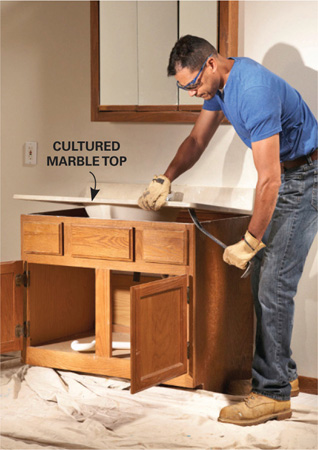
1 Tear out the vanity. Disconnect the plumbing and pry off the old top. Then remove the vanity cabinet and old medicine cabinet or mirror.
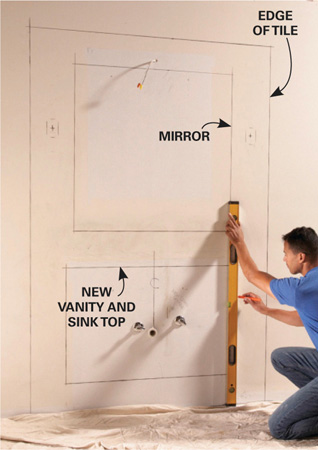
2 Draw outlines on the wall. Outline the new fixtures, mirror and tile on the wall. Then decide where the new lights should go and mark these.
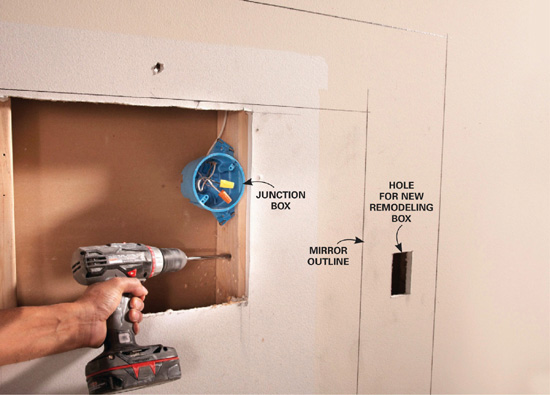
3 Reroute electrical lines. Cut a large hole so it’s easy to mount a new junction box and drill holes for the new wiring. Don’t worry about patching the wall; the hole will be covered by the mirror.
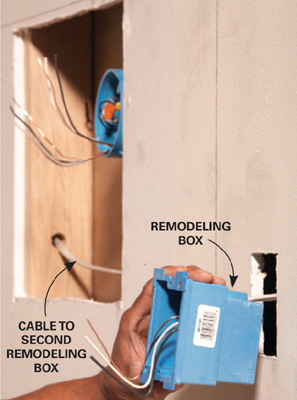
4 Mount the new light boxes. Run a cable from the junction box to the new remodeling boxes. Slide the box into the hole and tighten the screws to clamp it onto the drywall.
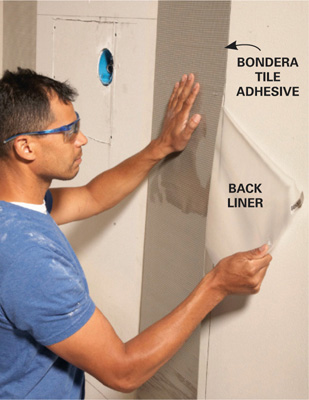
5 Apply the tile adhesive. Line up the edge of the tile adhesive with the tile line. Peel off the back liner as you press the adhesive to the wall.
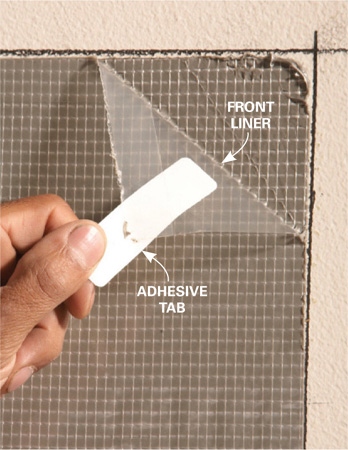
6 Peel off the front liner. Use the sticky tabs included with the tile adhesive to peel off the front liner. Once you get it started, it’s easy to peel off the rest.

7 Install the tile. Position the tile carefully and press it just hard enough to hold it in place. When you’re sure the tile is straight and the joints line up, tamp the tile with a grout float to adhere it.

8 Grout the tile. Press grout into the joints with a grout float. Sweep the float in diagonal strokes until the joints are completely filled. Then scrape off the excess grout with the edge of the float.
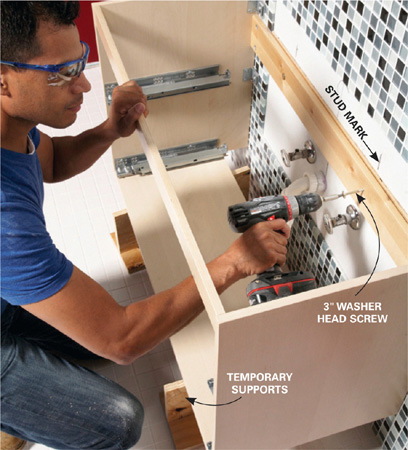
9 Hang the cabinet. Support the cabinet on temporary stands. Then drive screws through the hanging rail into the studs to secure the cabinet.
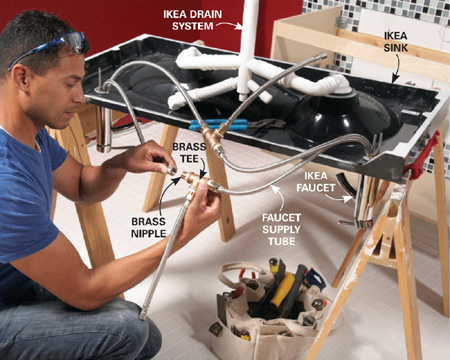
10 Mount the faucets. Follow the faucet instructions to mount the faucets to the sink. Installing the faucets and drain plumbing is easier if you do it before installing the sink on the cabinet.
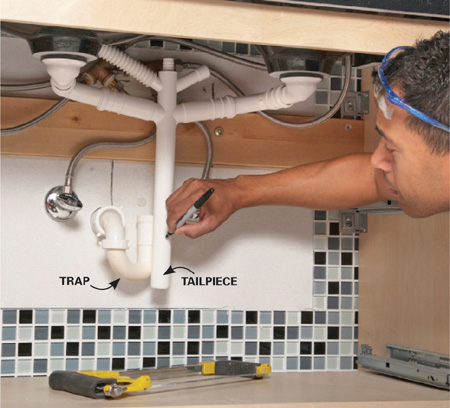
11 Connect the plumbing. Mark the tailpiece so that it will extend into the trap a few inches when it’s cut off. Cut it off with a hacksaw. Remove the trap. Slip it over the tailpiece and reconnect it. Connect the supply tubes to the shutoff valves. Turn on the water and check for leaks.
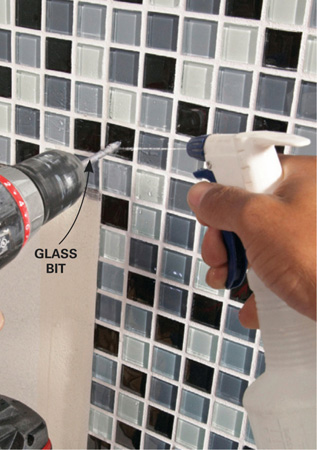
12 Drill mirror clip holes. Keep the glass bit cool by spraying water on it as you drill. Run the drill at slow to medium speed. Let up on the pressure when you’re almost through the tile.

13 Install the mirror clips. Tap a plastic hollow-wall anchor into the hole and screw the clip into the anchor. If the hole landed over a stud, you don’t need the anchor.
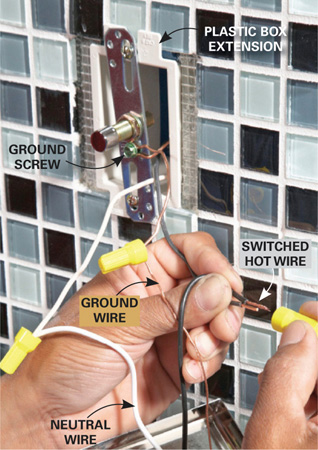
14 Wire the light fixtures. Slip a box extension into the electrical box if the tile is more than 1/4 in. thick. Then mount the fixture strap to the box and connect the wires.
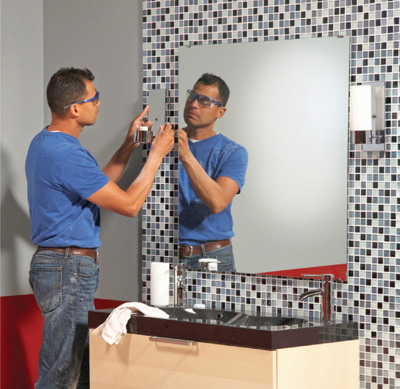
15 Finish up. Hang the mirror, paint the walls and mount the light fixtures. We installed new trim to match the cabinet.